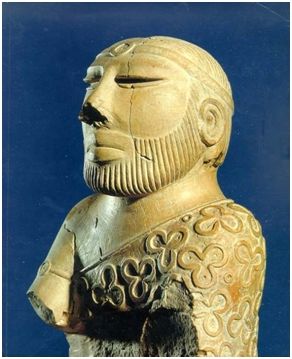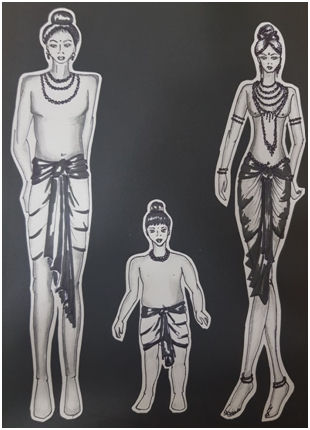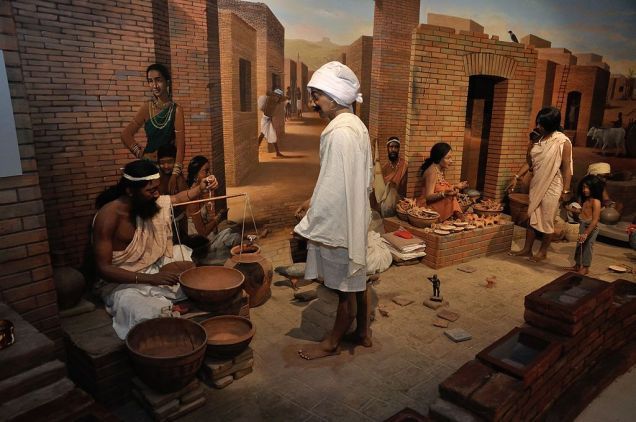Costumes: During Indus Valley Civilization
Clothing and costumes during ancient civilizations
The earliest evidence of textile production in India comes from the Indus Valley, where a complete Urban civilization centred around the two cities of Mahenjodaro and Harappa, thrived between 2500 and 2000 BC. Along with the many figurines and engraved seals, numerous spindle whorls of wool and coarse cotton, some copper sewing needles were found.
The recent discovery of excavated seals at the port town of Lothal on the west coast of Gujarat and Dhula-vira in Kutch, indicate that the sophisticated culture, already engaging in the export trade, was in place before this time. The earliest textile impression found in the subcontinent comes from Mehergarh, an Indus Valley site in Beluchistan. This impression of a woven fabric and a large number of cotton seeds also unearthed, date from 5000 BC. , by which time that appears cotton cultivation and textile weaving were already advanced.
The earliest evidence of textile production in India comes from the Indus Valley, where a complete Urban civilization centred around the two cities of Mahenjodaro and Harappa, thrived between 2500 and 2000 BC. Along with the many figurines and engraved seals, numerous spindle whorls of wool and coarse cotton, some copper sewing needles were found.
The recent discovery of excavated seals at the port town of Lothal on the west coast of Gujarat and Dhula-vira in Kutch, indicate that the sophisticated culture, already engaging in the export trade, was in place before this time. The earliest textile impression found in the subcontinent comes from Mehergarh, an Indus Valley site in Baluchistan. This impression of a woven fabric and a large number of cotton seeds also unearthed, date from 5000 BC. , by which time that appears cotton cultivation and textile weaving were already advanced.
Costumes
Our knowledge early Indian costume is based on the study of the sculpted figures and engraved seals found at the Indus valley sites. Both men and women are depicted wearing unstitched fabric draped around the body and variety of stitched clothes like tunics, cloaks, simple skirt and trousers.

One of the statues discovered in Mahenjodaro is the bust of a man generally thought to be a priest, although he may be a nobleman or even a deity. His stately appearance is created partly by his meditative expression and partly by his meditative expression and partly by the formal drape of his patterned robe or shawl which must have evolved from a defined sartorial tradition.

In comparing these two statues, one might be tempted to conclude that a class difference existed between the people they represent, as each reflects a very different social interpretation of beauty and style. This may not be the case, as it has been suggested that the Indus valley civilization was multi-ethnic.
There are many theories about the ethnic identities of the people who lived in Ancient India. In order to establish a context for this study, it is important to understand something of the beliefs and practices of the pre-Aryan inhabitants.
There are native tradition was centred on the fertility cults and the worship of the mother goddess, whom the figurine of the dancing girl is said to represent. Stylistically, it can be described as sensual and is associated with the early fertility cults involving the worship of male and female deities of procreation, whose powers were called upon to induce creativity in all things and stimulate the varying pulse of life itself. This celebration of life has and still has a direct bearing on the evolution of clothing styles.
While nudity or minimal use of clothing is often associated with the primitive or undeveloped cultures, the unstitched garment was worn in the sophisticated urban environment and remained the proffered form of aristocratic dress throughout India’s history.

The unstitched garment is no less sophisticated because it is not sewn. Wrapped or draped garments are as structured by their definitive drape as those that are stitched and follow conventions and proportions dictated by socio-cultural norms.
The extraordinary variety of beliefs and customs that characterize the Indian way of life reflect a social order that does not demand a high degree of uniformity. It was perhaps that freedom of expression and lack of censorship that determined the choice of clothing, allowing for the development of a society in which men and women could reject the constraints of stitched clothing.
The role of clothing as portrayed in Indian art is not to hide or clothe the body, but to adorn it, like jewellery and to accentuate its sensuous attributes. The artistic evidence we have leads us to believe that the royalty of ancient India was affluent and wore little clothing out of choice and not economic necessity.
Textiles are ritual symbols of renewal, as old clothes are discarded and replaced by newly woven fabric. In their basic form, the sarees and dhotis of modern-day India are not much different from the off-the loom fabrics worn in ancient times.
The ancient costume was not made up exclusively of unstitched cloth. However, it was often thought that the art of sewing was unknown to the Indians until the Muslim invasion and that the stitch garment was not part of the indigenous Indian tradition.

Conclusion
This theory has been disproved by the much literacy, sculptural and visual references relating to the ancient period. The nobility may have preferred unstitched clothing, especially in the warmer part of the clothing repertoire, particularly in the colder regions. the earliest stitched clothes were basic, but later there evolved more complex designs which were often combined with unstitched garments to make up layered ensembles.
References:
- https://en.wikipedia.org/wiki/History_of_clothing_in_the_Indian
- https://en.wikipedia.org/wiki/Dancing_Girl_(sculpture)


